[English] 日本語
 Yorodumi
Yorodumi- PDB-3bux: Crystal structure of c-Cbl-TKB domain complexed with its binding ... -
+ Open data
Open data
- Basic information
Basic information
| Entry | Database: PDB / ID: 3bux | ||||||
|---|---|---|---|---|---|---|---|
| Title | Crystal structure of c-Cbl-TKB domain complexed with its binding motif in c-Met | ||||||
 Components Components |
| ||||||
 Keywords Keywords | LIGASE/SIGNALING PROTEIN / Cbl / TKB / ligase / signal transduction / proto-oncogene / complex / ATP-binding / Glycoprotein / Kinase / Membrane / Nucleotide-binding / Phosphoprotein / Receptor / Transferase / Transmembrane / Tyrosine-protein kinase / Calcium / Cytoplasm / Metal-binding / SH2 domain / Ubl conjugation pathway / Zinc / Zinc-finger / LIGASE-SIGNALING PROTEIN COMPLEX | ||||||
| Function / homology |  Function and homology information Function and homology informationregulation of platelet-derived growth factor receptor-alpha signaling pathway / ubiquitin-dependent endocytosis / regulation of Rap protein signal transduction / negative regulation of guanyl-nucleotide exchange factor activity / hepatocyte growth factor receptor activity / Drug-mediated inhibition of MET activation / MET activates STAT3 / negative regulation of hydrogen peroxide-mediated programmed cell death / MET Receptor Activation / MET interacts with TNS proteins ...regulation of platelet-derived growth factor receptor-alpha signaling pathway / ubiquitin-dependent endocytosis / regulation of Rap protein signal transduction / negative regulation of guanyl-nucleotide exchange factor activity / hepatocyte growth factor receptor activity / Drug-mediated inhibition of MET activation / MET activates STAT3 / negative regulation of hydrogen peroxide-mediated programmed cell death / MET Receptor Activation / MET interacts with TNS proteins / flotillin complex / endothelial cell morphogenesis / phosphatidylinositol 3-kinase regulatory subunit binding / semaphorin receptor activity / MET receptor recycling / pancreas development / MET activates PTPN11 / MET activates RAP1 and RAC1 / Sema4D mediated inhibition of cell attachment and migration / MET activates PI3K/AKT signaling / positive regulation of endothelial cell chemotaxis / negative regulation of stress fiber assembly / MET activates PTK2 signaling / Regulation of KIT signaling / positive regulation of epidermal growth factor receptor signaling pathway / Interleukin-6 signaling / mast cell degranulation / response to starvation / branching morphogenesis of an epithelial tube / positive chemotaxis / negative regulation of Rho protein signal transduction / response to testosterone / negative regulation of epidermal growth factor receptor signaling pathway / negative regulation of thrombin-activated receptor signaling pathway / TGF-beta receptor signaling activates SMADs / semaphorin-plexin signaling pathway / protein monoubiquitination / establishment of skin barrier / MET activates RAS signaling / Regulation of MITF-M-dependent genes involved in cell cycle and proliferation / protein autoubiquitination / MECP2 regulates neuronal receptors and channels / ephrin receptor binding / cellular response to platelet-derived growth factor stimulus / phosphotyrosine residue binding / positive regulation of microtubule polymerization / FLT3 signaling by CBL mutants / Negative regulation of FLT3 / PTK6 Regulates RTKs and Their Effectors AKT1 and DOK1 / negative regulation of autophagy / cell surface receptor protein tyrosine kinase signaling pathway / basal plasma membrane / molecular function activator activity / InlB-mediated entry of Listeria monocytogenes into host cell / response to activity / response to gamma radiation / excitatory postsynaptic potential / Regulation of signaling by CBL / Negative regulation of FGFR3 signaling / Negative regulation of FGFR2 signaling / Negative regulation of FGFR4 signaling / Negative regulation of FGFR1 signaling / EGFR downregulation / liver development / Spry regulation of FGF signaling / Constitutive Signaling by EGFRvIII / Negative regulation of MET activity / receptor protein-tyrosine kinase / cellular response to nerve growth factor stimulus / receptor tyrosine kinase binding / RING-type E3 ubiquitin transferase / positive regulation of receptor-mediated endocytosis / SH3 domain binding / male gonad development / neuron differentiation / cytokine-mediated signaling pathway / protein polyubiquitination / Signaling by CSF1 (M-CSF) in myeloid cells / Constitutive Signaling by Aberrant PI3K in Cancer / ubiquitin-protein transferase activity / ubiquitin protein ligase activity / Cargo recognition for clathrin-mediated endocytosis / PIP3 activates AKT signaling / Constitutive Signaling by Ligand-Responsive EGFR Cancer Variants / Clathrin-mediated endocytosis / growth cone / PI5P, PP2A and IER3 Regulate PI3K/AKT Signaling / RAF/MAP kinase cascade / protein tyrosine kinase activity / ubiquitin-dependent protein catabolic process / response to ethanol / protein phosphatase binding / cellular response to hypoxia / cell surface receptor signaling pathway / positive regulation of phosphatidylinositol 3-kinase/protein kinase B signal transduction / receptor complex / postsynapse / protein ubiquitination / cilium / cadherin binding Similarity search - Function | ||||||
| Biological species |  Homo sapiens (human) Homo sapiens (human) | ||||||
| Method |  X-RAY DIFFRACTION / X-RAY DIFFRACTION /  SYNCHROTRON / SYNCHROTRON /  MOLECULAR REPLACEMENT / MOLECULAR REPLACEMENT /  molecular replacement / Resolution: 1.35 Å molecular replacement / Resolution: 1.35 Å | ||||||
 Authors Authors | Ng, C. / Jackson, R.A. / Buschdorf, J.P. / Sun, Q. / Guy, G.R. / Sivaraman, J. | ||||||
 Citation Citation |  Journal: Embo J. / Year: 2008 Journal: Embo J. / Year: 2008Title: Structural basis for a novel intrapeptidyl H-bond and reverse binding of c-Cbl-TKB domain substrates Authors: Ng, C. / Jackson, R.A. / Buschdorf, J.P. / Sun, Q. / Guy, G.R. / Sivaraman, J. | ||||||
| History |
|
- Structure visualization
Structure visualization
| Structure viewer | Molecule:  Molmil Molmil Jmol/JSmol Jmol/JSmol |
|---|
- Downloads & links
Downloads & links
- Download
Download
| PDBx/mmCIF format |  3bux.cif.gz 3bux.cif.gz | 153.9 KB | Display |  PDBx/mmCIF format PDBx/mmCIF format |
|---|---|---|---|---|
| PDB format |  pdb3bux.ent.gz pdb3bux.ent.gz | 119 KB | Display |  PDB format PDB format |
| PDBx/mmJSON format |  3bux.json.gz 3bux.json.gz | Tree view |  PDBx/mmJSON format PDBx/mmJSON format | |
| Others |  Other downloads Other downloads |
-Validation report
| Summary document |  3bux_validation.pdf.gz 3bux_validation.pdf.gz | 469 KB | Display |  wwPDB validaton report wwPDB validaton report |
|---|---|---|---|---|
| Full document |  3bux_full_validation.pdf.gz 3bux_full_validation.pdf.gz | 495.9 KB | Display | |
| Data in XML |  3bux_validation.xml.gz 3bux_validation.xml.gz | 34.1 KB | Display | |
| Data in CIF |  3bux_validation.cif.gz 3bux_validation.cif.gz | 50.5 KB | Display | |
| Arichive directory |  https://data.pdbj.org/pub/pdb/validation_reports/bu/3bux https://data.pdbj.org/pub/pdb/validation_reports/bu/3bux ftp://data.pdbj.org/pub/pdb/validation_reports/bu/3bux ftp://data.pdbj.org/pub/pdb/validation_reports/bu/3bux | HTTPS FTP |
-Related structure data
| Related structure data | 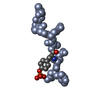 3bumC 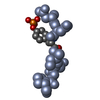 3bunC 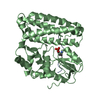 3buoC 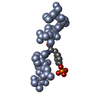 3buwC 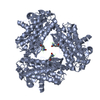 2cblS C: citing same article ( S: Starting model for refinement |
|---|---|
| Similar structure data |
- Links
Links
- Assembly
Assembly
| Deposited unit | 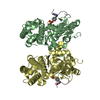
| ||||||||
|---|---|---|---|---|---|---|---|---|---|
| 1 | 
| ||||||||
| 2 | 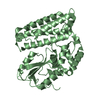
| ||||||||
| 3 | 
| ||||||||
| 4 | 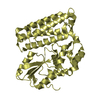
| ||||||||
| 5 | 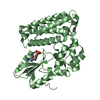
| ||||||||
| 6 | 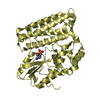
| ||||||||
| Unit cell |
|
- Components
Components
| #1: Protein/peptide | Mass: 1595.537 Da / Num. of mol.: 2 / Fragment: UNP residues 997-1009, pTyr-1003 phosphopeptide / Source method: obtained synthetically / Details: synthetic construct / References: UniProt: P08581 #2: Protein | Mass: 38192.090 Da / Num. of mol.: 2 Fragment: c-Cbl TKB domain, CBL N-terminal, UNP residues 23-351 Source method: isolated from a genetically manipulated source Source: (gene. exp.)  Homo sapiens (human) / Gene: CBL, CBL2, RNF55 Homo sapiens (human) / Gene: CBL, CBL2, RNF55Plasmid details: Cas-Br-M (murine) ecotropic retroviral transforming sequence Plasmid: pGEX4T1 / Production host:  References: UniProt: P22681, Ligases; Forming carbon-nitrogen bonds; Acid-amino-acid ligases (peptide synthases) #3: Water | ChemComp-HOH / | Has protein modification | Y | |
|---|
-Experimental details
-Experiment
| Experiment | Method:  X-RAY DIFFRACTION / Number of used crystals: 1 X-RAY DIFFRACTION / Number of used crystals: 1 |
|---|
- Sample preparation
Sample preparation
| Crystal | Density Matthews: 2.19 Å3/Da / Density % sol: 43.78 % |
|---|---|
| Crystal grow | Temperature: 298 K / Method: vapor diffusion, hanging drop / pH: 7 Details: 0.15M malic acid, 20% PEG 3350, pH 7.0, VAPOR DIFFUSION, HANGING DROP, temperature 298K |
-Data collection
| Diffraction | Mean temperature: 100 K | ||||||||||||||||||||||||||||||||||||||||||||||||||||||||||||||||||
|---|---|---|---|---|---|---|---|---|---|---|---|---|---|---|---|---|---|---|---|---|---|---|---|---|---|---|---|---|---|---|---|---|---|---|---|---|---|---|---|---|---|---|---|---|---|---|---|---|---|---|---|---|---|---|---|---|---|---|---|---|---|---|---|---|---|---|---|
| Diffraction source | Source:  SYNCHROTRON / Site: SYNCHROTRON / Site:  NSLS NSLS  / Beamline: X29A / Wavelength: 1 Å / Beamline: X29A / Wavelength: 1 Å | ||||||||||||||||||||||||||||||||||||||||||||||||||||||||||||||||||
| Detector | Type: ADSC QUANTUM 315 / Detector: CCD / Date: Mar 25, 2007 | ||||||||||||||||||||||||||||||||||||||||||||||||||||||||||||||||||
| Radiation | Protocol: SINGLE WAVELENGTH / Scattering type: x-ray | ||||||||||||||||||||||||||||||||||||||||||||||||||||||||||||||||||
| Radiation wavelength | Wavelength: 1 Å / Relative weight: 1 | ||||||||||||||||||||||||||||||||||||||||||||||||||||||||||||||||||
| Reflection | Resolution: 1.35→50 Å / Num. obs: 142289 / % possible obs: 95 % / Redundancy: 6.5 % / Rmerge(I) obs: 0.04 / Χ2: 0.608 / Net I/σ(I): 11.6 | ||||||||||||||||||||||||||||||||||||||||||||||||||||||||||||||||||
| Reflection shell |
|
-Phasing
| Phasing | Method:  molecular replacement molecular replacement | |||||||||
|---|---|---|---|---|---|---|---|---|---|---|
| Phasing MR |
|
- Processing
Processing
| Software |
| ||||||||||||||||||||||||||||||||
|---|---|---|---|---|---|---|---|---|---|---|---|---|---|---|---|---|---|---|---|---|---|---|---|---|---|---|---|---|---|---|---|---|---|
| Refinement | Method to determine structure:  MOLECULAR REPLACEMENT MOLECULAR REPLACEMENTStarting model: PDB ENTRY 2CBL Resolution: 1.35→20 Å / Cross valid method: THROUGHOUT / σ(F): 11808
| ||||||||||||||||||||||||||||||||
| Solvent computation | Bsol: 52.376 Å2 | ||||||||||||||||||||||||||||||||
| Displacement parameters | Biso mean: 18.448 Å2
| ||||||||||||||||||||||||||||||||
| Refinement step | Cycle: LAST / Resolution: 1.35→20 Å
| ||||||||||||||||||||||||||||||||
| Refine LS restraints |
| ||||||||||||||||||||||||||||||||
| Xplor file |
|
 Movie
Movie Controller
Controller


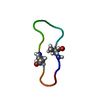


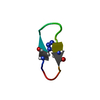

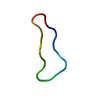
 PDBj
PDBj














